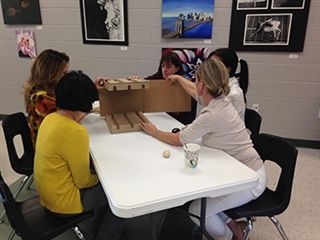

Hands on, Minds on Learning at Shorecrest
Source/Author: Tracie Belt
November 14, 2014
Last week, TLC hosted a parent Lunch and Learn highlighting how Shorecrest teachers implement research based curriculum trends which build important 21st Century skills such as communication, collaboration, critical thinking, and creativity. The presentation featured teacher-led classes and clubs which provide our students with educational experiences and enhance their ability to be competitive in a changing 21st century world and job market.
Current educational research shows that to be competitive, schools must provide opportunities to improve critical thinking and problem solving. To be critical thinkers our students need to learn with a hands on, mind on approach. This type of approach makes learning stick, which in turn gives students the skills and knowledge to make it easy to apply what they have learned to real life problem solving.
TLC loves anything that improves learning, so we were proud to host a “Make to Learn” parent workshop. If you missed it you missed hearing how trends such as: S.T.E.A.M. (science, technology, engineering, art, and math), project based learning, Robotics, integration of the arts with other curriculum areas, and the Makers Movement are used by our Shorecrest teachers in every division.
Current educational research shows that to be competitive, schools must provide opportunities to improve critical thinking and problem solving. To be critical thinkers our students need to learn with a hands on, mind on approach. This type of approach makes learning stick, which in turn gives students the skills and knowledge to make it easy to apply what they have learned to real life problem solving.
TLC loves anything that improves learning, so we were proud to host a “Make to Learn” parent workshop. If you missed it you missed hearing how trends such as: S.T.E.A.M. (science, technology, engineering, art, and math), project based learning, Robotics, integration of the arts with other curriculum areas, and the Makers Movement are used by our Shorecrest teachers in every division.
Why is this relevant and important to you as parents?
Your children are all 21st Century learners and need to have the skills and qualities that will give them an edge in college, the workplace, and as a member of our emerging global society and economy.
What qualities and skills will your child need in the 21st Century?
21st Century learners will continue to need a rich knowledge of subject matter, strong reading and writing skills, and teachers who teach our children strategies and techniques that show them how to learn - all of which are part of our rigorous Shorecrest curriculum.
According to the research quoted in Defining a 21st century Education by Craig D. Jerald:
According to the research quoted in Defining a 21st century Education by Craig D. Jerald:
“21st century employers are looking for “People who are comfortable working in artistic, investigative, highly social, or entrepreneurial environments are likely to succeed,” as U.S. companies strive to become high-performance environments focused on innovation. “Schools will have to learn how to simulate these environments in many ways if our students are to develop the abilities that will be so important to them.” The learning environment in schools should enhance and promote so-called “soft skills” that most employers state are essential in the new career fields. The soft skills that employers will be looking for in their applicants are critical thinking, creativity, collaboration, and communication skills. The students who will have an edge in the job market need to have learning experiences that promote open-ended curiosity, students who are comfortable with finding “no right answer,” creativity, taking personal responsibility for identifying and solving problems—in other words, experiences that reflects the evolving workplace environment. “
Interested in knowing more?
The workshop featured a sampling of how Shorecrest teachers are implementing S.T.E.A.M. (science, technology, engineering, art, and math), project based learning, Robotics, the integration of the arts with other curriculum areas, and the Makers Movement. The session included an overview of research on learning presented by Tracie Belt. Following the overview, guest speakers Aaron Sober (US art), Dr. Anna Baralt (Director of Educational Technology) and Courtney Walker (Media Specialist) spoke on how STEAM and Robotics teach students to combine their skills from all of the curriculum areas so that they can apply this knowledge to solve problems, practice critical thinking, collaborate, and hone communication skills such as writing, public speaking, interpersonal communication skills.
Watch the short Slide Presentation about Shorecrest’s 21st century approach to learning that sticks: Making to Learn
Watch the short Slide Presentation about Shorecrest’s 21st century approach to learning that sticks: Making to Learn

















